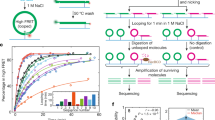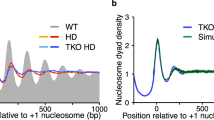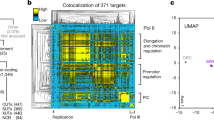Abstract
The nucleosome is the fundamental building block of eukaryotic chromosomes. Access to genetic information encoded in chromosomes is dependent on the position of nucleosomes along the DNA. Alternative locations just a few nucleotides apart can have profound effects on gene expression1. Yet the nucleosomal context in which chromosomal and gene regulatory elements reside remains ill-defined on a genomic scale. Here we sequence the DNA of 322,000 individual Saccharomyces cerevisiae nucleosomes, containing the histone variant H2A.Z, to provide a comprehensive map of H2A.Z nucleosomes in functionally important regions. With a median 4-base-pair resolution, we identify new and established signatures of nucleosome positioning. A single predominant rotational setting and multiple translational settings are evident. Chromosomal elements, ranging from telomeres to centromeres and transcriptional units, are found to possess characteristic nucleosomal architecture that may be important for their function. Promoter regulatory elements, including transcription factor binding sites and transcriptional start sites, show topological relationships with nucleosomes, such that transcription factor binding sites tend to be rotationally exposed on the nucleosome surface near its border. Transcriptional start sites tended to reside about one helical turn inside the nucleosome border. These findings reveal an intimate relationship between chromatin architecture and the underlying DNA sequence it regulates.
This is a preview of subscription content, access via your institution
Access options
Subscribe to this journal
Receive 51 print issues and online access
$199.00 per year
only $3.90 per issue
Buy this article
- Purchase on Springer Link
- Instant access to full article PDF
Prices may be subject to local taxes which are calculated during checkout




Similar content being viewed by others
References
Martinez-Campa, C. et al. Precise nucleosome positioning and the TATA box dictate requirements for the histone H4 tail and the bromodomain factor Bdf1. Mol. Cell 15, 69–81 (2004)
Richmond, T. J. & Davey, C. A. The structure of DNA in the nucleosome core. Nature 423, 145–150 (2003)
Satchwell, S. C., Drew, H. R. & Travers, A. A. Sequence periodicities in chicken nucleosome core DNA. J. Mol. Biol. 191, 659–675 (1986)
Segal, E. et al. A genomic code for nucleosome positioning. Nature 442, 772–778 (2006)
Ioshikhes, I. P., Albert, I., Zanton, S. J. & Pugh, B. F. Nucleosome positions predicted through comparative genomics. Nature Genet. 38, 1210–1215 (2006)
Yuan, G. C. et al. Genome-scale identification of nucleosome positions in S. cerevisiae. Science 309, 626–630 (2005)
Pokholok, D. K. et al. Genome-wide map of nucleosome acetylation and methylation in yeast. Cell 122, 517–527 (2005)
Li, B. et al. Preferential occupancy of histone variant H2AZ at inactive promoters influences local histone modifications and chromatin remodeling. Proc. Natl Acad. Sci. USA 102, 18385–18390 (2005)
Raisner, R. M. et al. Histone variant H2A.Z marks the 5′ ends of both active and inactive genes in euchromatin. Cell 123, 233–248 (2005)
Zhang, H., Roberts, D. N. & Cairns, B. R. Genome-wide dynamics of Htz1, a histone H2A variant that poises repressed/basal promoters for activation through histone loss. Cell 123, 219–231 (2005)
Guillemette, B. et al. Variant histone H2A.Z is globally localized to the promoters of inactive yeast genes and regulates nucleosome positioning. PLoS Biol. 3, e384 (2005)
Luger, K., Mäder, A. W., Richmond, R. K., Sargent, D. F. & Richmond, T. J. Crystal structure of the nucleosome core particle at 2.8 A resolution. Nature 389, 251–260 (1997)
Malave, T. M. & Dent, S. Y. Transcriptional repression by Tup1–Ssn6. Biochem. Cell Biol. 84, 437–443 (2006)
Pinto, I. & Winston, F. Histone H2A is required for normal centromere function in Saccharomyces cerevisiae. EMBO J. 19, 1598–1612 (2000)
Krogan, N. J. et al. Regulation of chromosome stability by the histone H2A variant Htz1, the Swr1 chromatin remodeling complex, and the histone acetyltransferase NuA4. Proc. Natl Acad. Sci. USA 101, 13513–13518 (2004)
Lipford, J. R. & Bell, S. P. Nucleosomes positioned by ORC facilitate the initiation of DNA replication. Mol. Cell 7, 21–30 (2001)
Nieduszynski, C. A., Knox, Y. & Donaldson, A. D. Genome-wide identification of replication origins in yeast by comparative genomics. Genes Dev. 20, 1874–1879 (2006)
Basehoar, A. D., Zanton, S. J. & Pugh, B. F. Identification and distinct regulation of yeast TATA box-containing genes. Cell 116, 699–709 (2004)
Bernstein, B. E., Liu, C. L., Humphrey, E. L., Perlstein, E. O. & Schreiber, S. L. Global nucleosome occupancy in yeast. Genome Biol. 5, R62 (2004)
Boeger, H., Griesenbeck, J., Strattan, J. S. & Kornberg, R. D. Removal of promoter nucleosomes by disassembly rather than sliding in vivo. Mol. Cell 14, 667–673 (2004)
Lee, C. K., Shibata, Y., Rao, B., Strahl, B. D. & Lieb, J. D. Evidence for nucleosome depletion at active regulatory regions genome-wide. Nature Genet. 36, 900–905 (2004)
Holstege, F. C. et al. Dissecting the regulatory circuitry of a eukaryotic genome. Cell 95, 717–728 (1998)
Gavin, I. M. & Simpson, R. T. Interplay of yeast global transcriptional regulators Ssn6p–Tup1p and Swi–Snf and their effect on chromatin structure. EMBO J. 16, 6263–6271 (1997)
Kim, J. M., Vanguri, S., Boeke, J. D., Gabriel, A. & Voytas, D. F. Transposable elements and genome organization: a comprehensive survey of retrotransposons revealed by the complete Saccharomyces cerevisiae genome sequence. Genome Res. 8, 464–478 (1998)
Kellis, M., Patterson, N., Endrizzi, M., Birren, B. & Lander, E. S. Sequencing and comparison of yeast species to identify genes and regulatory elements. Nature 423, 241–254 (2003)
Cliften, P. et al. Finding functional features in Saccharomyces genomes by phylogenetic footprinting. Science 301, 71–76 (2003)
Harbison, C. T. et al. Transcriptional regulatory code of a eukaryotic genome. Nature 431, 99–104 (2004)
Lee, T. I. et al. Transcriptional regulatory networks in Saccharomyces cerevisiae. Science 298, 799–804 (2002)
MacIsaac, K. D. et al. An improved map of conserved regulatory sites for Saccharomyces cerevisiae. BMC Bioinformatics 7, 113 (2006)
David, L. et al. A high-resolution map of transcription in the yeast genome. Proc. Natl Acad. Sci. USA 103, 5320–5325 (2006)
Acknowledgements
We thank R. Albert for computational support, and S. Tan, J. Reese, D. Gilmour, and Y. Wang for many helpful discussions. This work was supported by a grant from NIH.
Author Contributions I.A. developed computational approaches to derive nucleosome maps from the read locations and developed the associated browser; T.N.M. prepared and purified the nucleosomes; L.P.T. constructed libraries and sequenced nucleosomal DNA; J.Q. mapped sequencing reads to the yeast genome; S.J.Z. produced Supplementary Tables 2 and 3; S.C.S. managed and directed the DNA sequencing phase, and analysed the sequencing data; and B.F.P. directed the project, analysed the processed data, and wrote the paper.
Author information
Authors and Affiliations
Corresponding author
Ethics declarations
Competing interests
Reprints and permissions information is available at www.nature.com/reprints. The authors declare no competing financial interests.
Supplementary information
Supplementary Information
This file contains Supplementary Methods, Supplementary Figures S1-S9 with Legends, Supplementary Table 2 and additional references. (PDF 3883 kb)
Supplementary Table 1
This file contains Supplementary Table 1. The Supplementary Table 1 contains the chromosomal coordinates of the top 46,809 translational settings (fine-grain positions) of the top 17,758 H2A.Z –containing coarse-grain nucleosomes. (XLS 12769 kb)
Supplementary Table 2
This file contains Supplementary Table 3. The Supplementary Table 3 contains additional and more detailed relationships between “very fuzzy” or “very wide” nucleosomes and published genomic information, than presented in Supplementary Table S2. (XLS 12730 kb)
Rights and permissions
About this article
Cite this article
Albert, I., Mavrich, T., Tomsho, L. et al. Translational and rotational settings of H2A.Z nucleosomes across the Saccharomyces cerevisiae genome. Nature 446, 572–576 (2007). https://doi.org/10.1038/nature05632
Received:
Accepted:
Issue Date:
DOI: https://doi.org/10.1038/nature05632
This article is cited by
-
Structure of the ISW1a complex bound to the dinucleosome
Nature Structural & Molecular Biology (2024)
-
Structures of transcription preinitiation complex engaged with the +1 nucleosome
Nature Structural & Molecular Biology (2023)
-
When transcription initiation meets chromatin
Nature Structural & Molecular Biology (2023)
-
Histone variant H2A.Z modulates nucleosome dynamics to promote DNA accessibility
Nature Communications (2023)
-
Chromatin remodeling factor, INO80, inhibits PMAIP1 in renal tubular cells via exchange of histone variant H2A.Z. for H2A
Scientific Reports (2023)
Comments
By submitting a comment you agree to abide by our Terms and Community Guidelines. If you find something abusive or that does not comply with our terms or guidelines please flag it as inappropriate.



